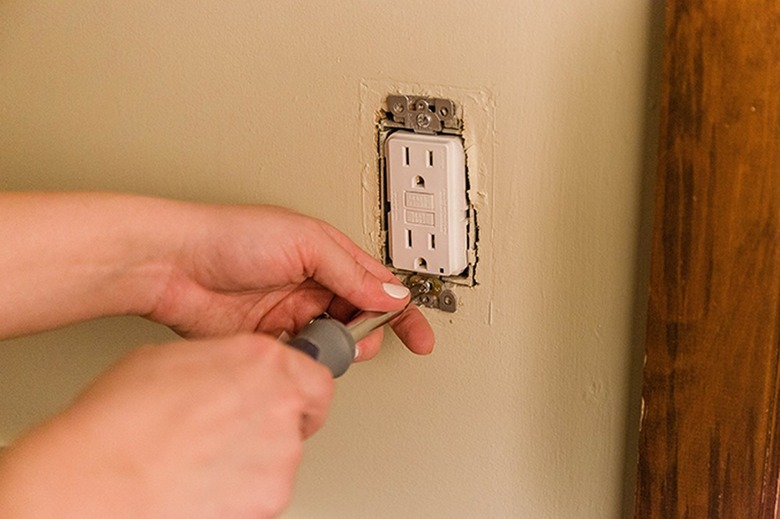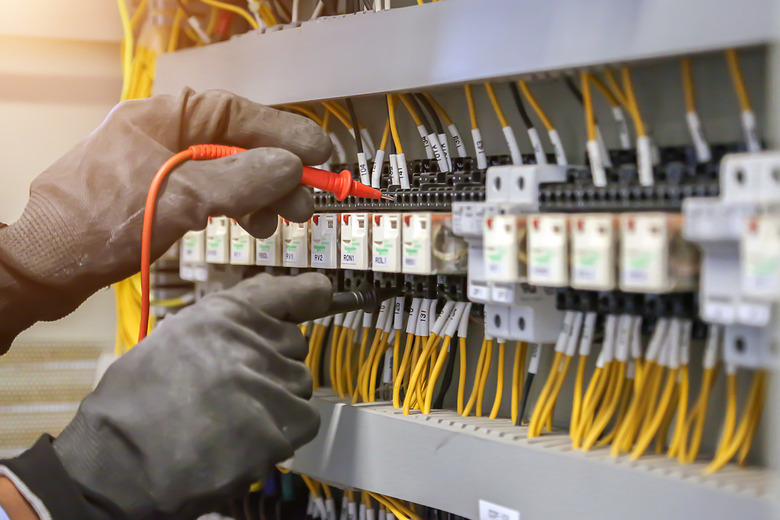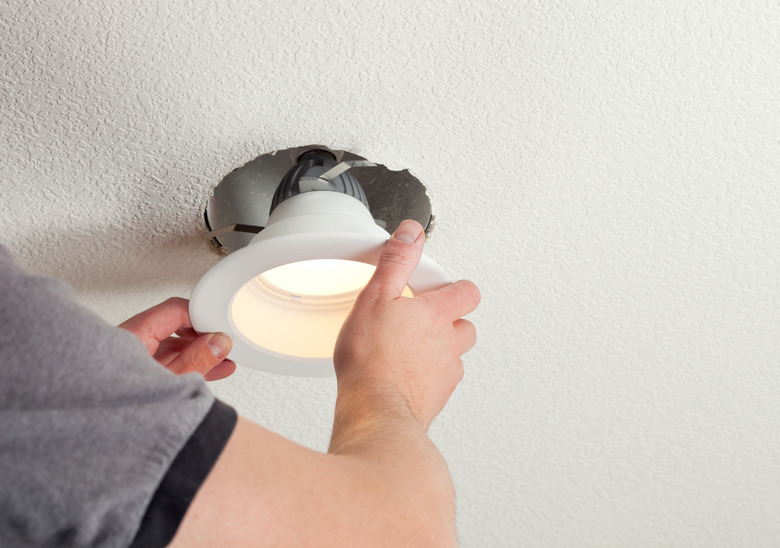Preventing Electric Shock — The Ultimate Safety Guide For Home Improvement Projects
We may receive a commission on purchases made from links.
To give an idea of the danger electric shock poses while you're working on your residential electrical system, consider that an electrical current of only 5 milliamperes (mA) is perceived as disturbing, 6 to 30 mA is painful and 50 to 150 mA can cause cardiac arrest. The current flowing in a residential circuit is in a range of 10 to 20 amps (10,000 to 20,000 mA), and besides inflicting severe burns, that much current can stop your heart and cause electrocution. The current flowing through 240-volt electrical circuits that feed your stove, water heater and central air system is even greater.
Whether or not a misstep results in electrocution depends on a number of factors, including the amperage of the current, how long you are exposed and the pathway the current takes through your body. It also matters whether your hands and feet are wet or dry, given that water on your body or around your feet is an electrical conductor. In any case, the best electrical shock is no shock at all, so when you're doing your own electrical work, it's important to follow these eight electrical safety protocols to prevent electric shock and electrical fire.
1. Dress for the Job
1. Dress for the Job
As a homeowner doing small fix-it jobs, like servicing switches, light fixtures and receptacles, you don't need to dress like an electrician, but some apparel items can definitely reduce the risk of electric shock. Chief among them are rubber-soled shoes to prevent electricity from flowing though your body into the ground if you touch a live wire. You should also wear goggles to protect your eyes from sparks. Remove bracelets, watches, long necklaces and other metal accessories to prevent accidental contact with wiring or electrical devices.
2. Use Insulated Tools
2. Use Insulated Tools
As a general rule, you should always use tools with electrically insulated handles. Rubber, plastic and wood are all electrical insulators, and that's what you should be touching (not the metal) while the tool is in contact with an electrical wire or terminal. That said, it's important that the tool be designed for electrical safety. Don't assume a screwdriver is insulated just because it has a plastic or rubber handle. Insulated tools tend to be high quality and don't have to cost a lot more than noninsulated tools. Look for the insulation rating provided by the manufacturer to confirm that the tool is designed for electrical safety.
3. Turn Off the Power
3. Turn Off the Power
The first step in any electrical procedure is to turn off the power, but that doesn't mean to simply turn off a light switch because someone could turn it on while you're working, and it might not even be the right switch. Instead, you should always turn off the circuit breaker in the main service panel that controls the circuit on which you'll be working. It goes without saying that you should also turn off the breaker before servicing a device that doesn't have a switch, such as an electrical outlet.
4. Test Before You Touch
4. Test Before You Touch
Turning off the breaker may not de-energize the device on which you're working; the breaker may be mislabeled or the electrical circuits in the house miswired. It's also possible that there are wires from more than one circuit running through a single electrical box. Before you touch wires or wire terminals, always use a voltage tester to make sure it's dead. If you're working on a receptacle, you can plug in a receptacle tester to see if there's power or not. You can also use this to check whether GFCI outlets are properly wired, although you'll probably never need this feature since GFCIs have their own test buttons.
If you use a two-wire voltage tester or a multimeter, touch one lead to the hot wire or the terminal to which it is connected and the other lead to a ground wire or terminal and make sure the light stays off or the meter reads zero volts. If you use a noncontact voltage tester, simply hold the tip of the tester near a hot wire or terminal (or touch it with the tip), and if there is no power, it will flash a green light or do nothing. Otherwise, it will either flash a red light, beep or both.
5. Use Extension Cords Safely
5. Use Extension Cords Safely
The National Electrical Code stipulates that extension cords are for temporary use only and should never be used to permanently power an indoor or outdoor appliance. Always inspect a cord before using it because damaged cords can cause electric shock, especially in places with standing water.
When using extension cords to plug in power tools outdoors, either use cords with built-in ground-fault circuit-interrupter (GFCI) protection or plug the cords into a GFCI outlet. It's also important to use cords large enough to handle the current draw of the electrical equipment you're using. Generally, you should choose a 14-gauge cord for a maximum current draw of 10 to 15 amps to prevent the cord from overheating and melting the insulation. Use a 12-gauge cord for heavier-duty work.
6. Ground All Three-Prong Adapters
6. Ground All Three-Prong Adapters
If the tool you want to use has a three-prong plug and the only available receptacle has only two slots, you can plug in a three-prong to two-prong adapter, but you must ground the adapter, or the tool won't be grounded and could give you a shock. This is easy to do because the adapter has a small metal grounding tab with a hole large enough for the screw that holds the cover plate.
Remove the screw, plug in the adapter, insert the screw through the hole, screw it back into the outlet and, if the outlet box is grounded, the adapter will be grounded too. If you have an older home with outdated wiring, the outlet may not be grounded, so check it by inserting one lead from a voltage tester into the hot side of the outlet and touching the other lead to the cover plate screw. If the tester lights up, you're good to go. If not and the slots are the same size, try the other one. If you cannot confirm that the box is grounded, do not use the outlet. Instead, use a grounded (three-prong) extension cord and plug it into a grounded outlet or a GFCI outlet.
7. Avoid Moisture and Water
7. Avoid Moisture and Water
Prevent electric shock by working in dry conditions. That means more than simply avoiding working around standing water or in rainy weather. Even humid air can promote current flow between exposed electrical wires or terminals and your skin, which conducts electricity even better if you're sweating. If you're working outside in humid weather, make an extra effort to stay away from power lines even if you aren't doing electrical work, and any time you're working on electrical appliances, make sure the surroundings are dry, including the floor and walls.
8. Make Safe Wiring Connections
8. Make Safe Wiring Connections
Whether you're installing a switch, an outlet or a light fixture, you'll have to twist wires together to connect them, and you should always use pliers to do this even if you think your fingers are strong enough. Using pliers, you'll get a tighter twist that's less likely to separate, and if you twist clockwise, the connection will be even stronger when you screw on a wire connector (wire nut). If you twist counterclockwise, on the other hand, the connection will loosen when you screw on the cap. Loose wires can cause shocks and fires.
Alternatively, if you use push-in wire connectors, you won't twist the wires. Ensure safety with these connectors by stripping the wires to the correct length, pushing the wire all the way into the connector and making sure there is no exposed wire extending from the connector.
When installing a light fixture, always remove the light bulb first to prevent it from breaking if you lose your grip on the fixture. Also, make your life easier by labeling new wires you run through the walls. This will save you the trouble of having to test to find the live circuit wires in the future, and it will help to prevent miswiring.


